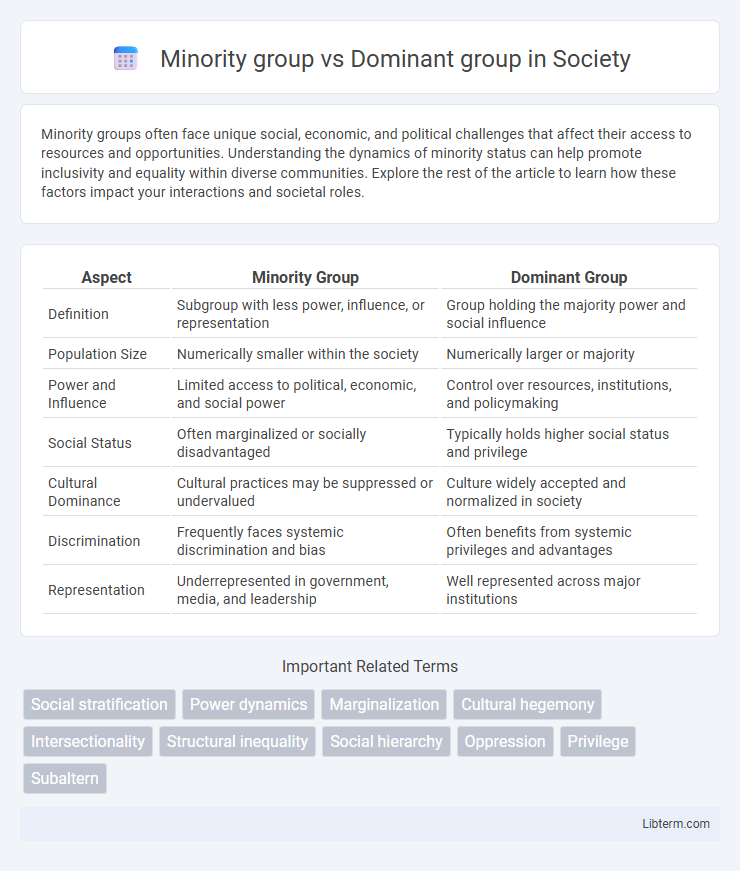Minority groups often face unique social, economic, and political challenges that affect their access to resources and opportunities. Understanding the dynamics of minority status can help promote inclusivity and equality within diverse communities. Explore the rest of the article to learn how these factors impact your interactions and societal roles.
Table of Comparison
| Aspect | Minority Group | Dominant Group |
|---|---|---|
| Definition | Subgroup with less power, influence, or representation | Group holding the majority power and social influence |
| Population Size | Numerically smaller within the society | Numerically larger or majority |
| Power and Influence | Limited access to political, economic, and social power | Control over resources, institutions, and policymaking |
| Social Status | Often marginalized or socially disadvantaged | Typically holds higher social status and privilege |
| Cultural Dominance | Cultural practices may be suppressed or undervalued | Culture widely accepted and normalized in society |
| Discrimination | Frequently faces systemic discrimination and bias | Often benefits from systemic privileges and advantages |
| Representation | Underrepresented in government, media, and leadership | Well represented across major institutions |
Defining Minority and Dominant Groups
Minority groups are defined by their smaller population size and limited access to power, resources, and social privileges compared to the dominant group. Dominant groups hold the majority of social, economic, and political influence within a society, shaping cultural norms and institutional policies. The distinction emphasizes power dynamics rather than mere numbers, with minority status often linked to systemic inequalities and marginalization.
Historical Context of Group Dynamics
Minority groups have historically faced systemic exclusion and discrimination within dominant group frameworks, shaping power imbalances and social hierarchies. Colonialism, slavery, and segregation exemplify how dominant groups exerted control over minorities, embedding institutional inequalities that persist across generations. Understanding these historical power dynamics is crucial for addressing contemporary social justice and equity issues.
Power Structures and Social Hierarchies
Minority groups often face systemic marginalization within power structures dominated by a dominant group that controls political, economic, and social resources. Social hierarchies reinforce this imbalance by privileging dominant group members through institutional policies and cultural norms, limiting minority access to opportunities and decision-making power. Power dynamics maintain the dominant group's hegemony, perpetuating disparities in wealth, education, and social status between minority and dominant populations.
Cultural Identity and Assimilation
Minority groups often maintain distinct cultural identities through language, traditions, and customs, which serve as a foundation for community cohesion and resistance to cultural erosion. Dominant groups typically exert pressure on minorities to assimilate, promoting mainstream values and practices that can lead to the gradual loss of unique cultural traits. The tension between preserving cultural identity and the forces of assimilation shapes social dynamics and influences policies related to multiculturalism and integration.
Representation in Media and Education
Minority groups often face underrepresentation and stereotypical portrayals in media, limiting their visibility and reinforcing societal biases, while dominant groups typically receive more diverse and positive representation that supports their cultural narratives. In education, curricula frequently center on the histories and perspectives of dominant groups, marginalizing minority experiences and contributing to a lack of cultural understanding among students. Increasing accurate representation of minority groups in media and incorporating inclusive educational content are crucial steps toward equity and social cohesion.
Discrimination and Systemic Inequality
Minority groups frequently face systemic inequality manifested through discriminatory policies, unequal access to education, healthcare, and employment opportunities compared to dominant groups. Institutional practices and societal norms often perpetuate disparities in income, political representation, and legal protections, reinforcing the power imbalance between minority and dominant populations. These entrenched inequalities contribute to social exclusion and limit the socioeconomic mobility of minority communities.
Social Movements and Advocacy
Minority groups, often facing systemic inequalities and underrepresentation, mobilize social movements to challenge dominant group control and demand equal rights, recognition, and access to resources. These advocacy efforts leverage grassroots organizing, strategic litigation, and public awareness campaigns to shift societal norms and influence policy changes. Dominant groups typically maintain power through institutional structures, making sustained activism crucial for minority groups to achieve social justice and equity.
Intersectionality Within Minority and Dominant Groups
Intersectionality within minority and dominant groups reveals complex layers of identity, where race, gender, class, and sexuality intersect to shape individual experiences of privilege and oppression. Minority groups often face compounded discrimination due to overlapping marginalized identities, while dominant groups may experience varied privilege depending on their intersecting social positions. Analyzing power dynamics through intersectionality offers deeper understanding of systemic inequalities beyond singular identity categories.
Impacts on Mental Health and Wellbeing
Minority groups often experience higher levels of stress, anxiety, and depression due to systemic discrimination, social exclusion, and limited access to mental health resources. Dominant groups typically have greater social privileges and support systems that contribute to more stable mental health outcomes. The disparities in societal power and access to care significantly impact the overall wellbeing of minority populations, exacerbating mental health challenges.
Strategies for Promoting Equity and Inclusion
Strategies for promoting equity and inclusion between minority and dominant groups include implementing comprehensive diversity training programs that address unconscious bias and cultural competency. Creating policies that ensure equal access to opportunities and resources, alongside fostering open communication channels for minority voices, enhances representation and participation. Establishing mentorship and sponsorship initiatives supports career advancement for minority group members and helps dismantle systemic barriers within organizations.
Minority group Infographic

 libterm.com
libterm.com